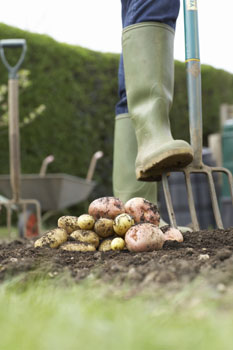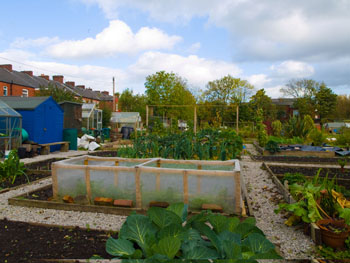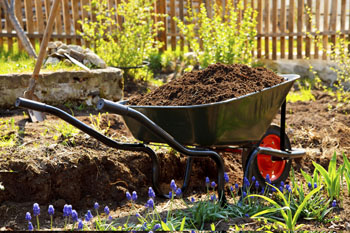- Step 1: Make sure you are not alone
- Step 2: Make a plan
- Step 3: Choose a site
- Step 4. Agree on garden rules
Community gardening involves cultivating people and relationships, as well as the soil. There are many ways to start a community garden. The four steps below provide guidance and suggestions that will help you create a successful community garden. The first step is critical.
Step 1: Make sure you are not alone
A community garden requires a community. You cannot do this alone. Many garden organizers have found the perfect garden place, provided infrastructure, prepared the soil and then been disappointed when gardeners fail to take an interest. Pull the people together first, get a commitment and then begin the garden.
The first task is to determine if there is sufficient interest in a garden. You need three to five people in a planning committee to get a community garden started.

To find people who may be interested in serving on a planning committee, talk about the garden. Tell your friends and neighbors. Be direct: "I'd like to start a community garden." Talk to churches, neighborhood associations, civic associations, clubs, shelters, apartments and businesses. These organizations will be able to help you spread the word and it is possible that they have land or other resources you can use. They may even be willing to sponsor the garden, assist with insurance issues and lend financial support. If the garden is for the benefit of a particular group or neighborhood, that group must be involved in all phases of the garden organization.
Ask for help. Many people are willing to help when specifically asked. Very few people respond to email blasts or Facebook postings. Ask an individual for help with a specific task. To get started you can use this template; just fill in the blanks.
"(Name), we are trying to get a community garden started. I need your help. Could you please (fill in the blank)."
If you are uncomfortable with rejection, just remember that "no" doesn't mean "never." It doesn?t mean you have a bad idea, and it doesn?t mean you are unloved. It just means no to that particular question or request. Ask someone else.
Once you have the three to five people who are willing to help you plan the garden, you are ready to proceed to Step 2.
Step 2: Make a plan
Now that you have organized a planning committee, be prepared to do everything yourself. You won't, but that will help keep you organized. You might consider creating business cards with an address, email, phone number, Facebook page and website. People will take you and your committee more seriously. They will be more inclined to help you if it looks like you know what you are doing. A business card can be an inexpensive and easy way to send that message. If possible, provide everyone on the planning committee with a card.

Hold a meeting of your planning committee and discuss these topics:
- What is your purpose?
- What are the long and short-term objectives?
- How will you choose leaders?
- Who will the garden serve?
- How will the produce be divided?
- Will there be conditions for membership (residence, dues, agreement with rules)?
- How will plots be assigned (by family size, residency, need or group)?
- How large will the plots be?
- How will the plots be laid out?
- When someone leaves a plot, how will the next gardener be chosen?
- If the group charges dues, how will the money be used? What services, if any, will be provided to gardeners in return?
- How will decisions be made?
- Will the gardeners meet regularly?
- Will trainings be held in the garden?
- Will there be rules concerning the use of chemicals or specific areas for organic gardening?
- How will minimum maintenance (especially weeding, weeding and more weeding) be handled both inside plots and in common areas (including along fences, in flower beds and in sitting areas)?
- How will work be shared? Who does what?
It is a lot to consider, but don't be intimidated. Many gardens are very informally organized and operate successfully for years. Leaders rise to the occasion to propose ideas and carry out tasks. As the workload expands, many groups choose a more formal structure for their organization.
New groups may benefit from several planning meetings. Once the planning committee has met and roughed out a “plan,” hold public meetings and advertise them enthusiastically.
If nobody shows up to the planning meetings, you either didn't advertise the meeting well enough or there is little interest. It is important to keep in mind that you can garden alone, but you cannot have a community garden alone. You will need committed gardeners to start a community garden.
Try out suggestions from these planning meetings and see what works. After a few months, you will be in a better position to develop bylaws or organizational guidelines.
Having a theme or cause with clear objectives, such as supporting a homeless shelter, religious group or unifying idea, can help pull participants together and provide cohesion to the community group.
Consider seeking a sponsor. Many gardens support themselves by collecting dues, but a little money from a sponsor can go a long way. Sponsoring organizations can help you in other ways, too. They may be able to provide land or tools and help with liability insurance. If you decide it is time for the garden to become a non-profit organization, a non-profit sponsor may be able to include your garden in their status.
Regardless of what is decided at meetings, make sure you record the contact information of every person who attends and note their expertise and talents. Keep these contacts up to date so you can ask for their help and keep them informed.
As with any committee, you will need to give up some control. Not all of your ideas will be accepted, and some new ideas will be introduced. The final plan may be better than the one you envisioned.
Step 3: Choose a site

Picking the right site will take time, so be patient. There are three requirements for the ideal garden location: It must have sunlight, water and an identified owner.
A vegetable garden must have at least six hours of sunlight per day. You can plant a successful ornamental garden with less light, but you cannot grow vegetables or fruit trees with less than six hours of sunlight per day.
Water is also critical. It is very difficult to raise vegetables and fruit without a consistent water source. If there isn?t a water source, contact the local water provider to get a hookup and meter installed. See if they will hook it up for free. It never hurts to ask.
Walk around the target area and look for vacant or abandoned lots. If you don't know who owns a property, write down the address and look up ownership records through the local tax assessor's office. Approach the owner about buying, leasing or simply using the land.

If the land isn't being used for anything else, landowners may be willing to lease it for a small fee or even barter for maintenance or fresh vegetables. Any agreement with the owner should permit gardening for at least three years. Churches, civic associations or municipalities may be able to help you access free land or they may have land you can borrow.
Land providers are likely to ask for two concessions: liability insurance and a Hold Harmless clause.
It is becoming increasingly difficult to obtain leases from landowners without obtaining liability insurance. Liability insurance protects the organization that owns it or some other entity (like a landowner) from being sued and held legally liable for injury or negligence. Liability insurance policies cover both legal costs and any legal payouts for which the insured would be responsible if found legally liable. Garden insurance is relatively new, and many insurance carriers are not familiar with it. Shop around because prices can vary considerably.
If a municipality requests insurance, talk to them. Cities and towns engage in lots of risky business (parks, sports fields, public events, etc.). They may be able to include your garden on their insurance at very little risk or cost. Your sponsors might be able to help your garden by including riders on their policy. Ask them. You have little to lose by asking.
Other location considerations are also important. The garden should be close to the gardeners. The closer the garden, the better - preferably within walking distance or, at most, a short drive away. The shorter the travel time, the more likely people are to stay involved in the garden.
You can turn almost any area into a garden with hard work and raised beds, but it is a lot easier if you can find a site that already has soil and isn?t covered with trees, garbage or building materials. A site with a secure fence is a plus. A fence will not stop all vandalism or deer, but it will help. Locked storage buildings for tools, water hoses and other supplies used by gardeners are also desirable.
Have the soil tested. You can contact your local UGA Cooperative Extension office for submission forms, instructions and sample containers (1-800-ASK-UGA-1). You can also order soil test kits online at aesl.ces.uga.edu.
Soil contamination may be a problem. Brownfields are lands that previously housed factories or commercial buildings and they may be contaminated with hydrocarbons, solvents, pesticides, heavy metals such as lead (e.g., paints), man-made organic compounds and asbestos. Small brownfields can be tucked into older urban residential areas as well. Long-gone dry cleaning establishments and gas stations may have produced high levels of contamination in the soil. If the history of the land suggests it may be a brownfield, you will want to do a more extensive soil test. Tell the soil testing lab about the prior history of the land so they can suggest tests that should be run. If results suggest contamination, you may want to choose another location. The other option is to install raised beds over a plastic liner or other impervious surface.
Step 4. Agree on garden rules

All community gardens need rules. This is especially important for new gardens. Rules spell out exactly what is expected of a gardener. They make it much easier to remove inactive gardeners with abandoned plots. Difficult and disruptive gardeners can be angry at the rules rather than the garden leaders or other gardeners. Below are a few sample rules. Some may be more relevant to your garden than others. Pick and choose what best fits your situation.
- I will pay a (monthly / annual) fee of $____ to help cover garden expenses.
- I will have something planted in the garden by (date) and keep it planted all summer long.
- If I must abandon my plot for any reason, I will notify the garden leaders.
- I will weed my plot and maintain the areas immediately surrounding my plot, if any.
- If my plot becomes unkempt, I understand I will be given a one-week notice to clean it up. It will be reassigned or tilled in if it is not cleaned.
- I will keep trash and litter cleaned from the plot, as well as from adjacent pathways and fences.
- I will participate in the fall cleanup of the garden.
- I will plant tall crops only where they will not shade neighboring plots.
- I will pick only my own crops unless given permission by another plot user.
- I will not use fertilizers or pesticides that will in any way affect other plots.
- I agree to volunteer hours toward community gardening efforts (include a list of volunteer tasks your garden needs).
- I will not bring pets to the garden.
It is also very important that each gardener/volunteer signs a Hold Harmless clause. This will protect you, your landlord, sponsoring organizations and your garden organization. Below is a sample clause.
"We the undersigned member of the (name) garden group hereby agree to hold harmless (name of land owner, garden group and sponsoring organizations) from and against any damage, loss, liability, claim, demand, suit, cost and expense directly or indirectly resulting from, arising out of or in connection with the use of the (name) garden group, its successors, assigns, employees, agents and invites."
Check your clause with a pro-bono lawyer to make sure you are covered.
Eventually, you may choose a more formal structure for your garden and develop formal bylaws, and perhaps even incorporate. There are two types of corporations: for profit corporations benefit the owners, nonprofit corporations are intended to further a purpose. Many community gardens are nonprofit corporations. There are several advantages to having nonprofit status, including tax exemption, ability to apply for private and government grants, limited liability, lower costs and good will (the public is more willing to work with your organization since you are doing something good for the public). There are some disadvantages as well. You will lose some control of the garden because it is not "owned" by its founders anymore. A board of directors makes decisions. There will be a lot more paperwork, and nonprofit finances are open to public inspection. As your garden grows and develops, the best path forward will appear and the garden will develop an appropriate governing structure.
After you have addressed the community aspects of your community garden, you will be ready to start gardening. Your county Cooperative Extension agent can prove an invaluable resource as you garden. Be sure to check UGA Cooperative Extension (https://extension.uga.edu/publications.html) for publications on preparing the site, testing the soil, constructing the beds, selecting the plants, managing pests, watering, mulching, harvesting, preserving food and food safety.
Gardening provides a great opportunity to get dirty, enjoy nature, exercise, beautify an area, and grow delicious and nutritious food. When gardening is done collectively, it is a great way to socialize and meet neighbors while sharing common interests.
Status and Revision History
Published on Mar 29, 2012
Published with Full Review on Mar 28, 2017
Published with Full Review on Apr 26, 2023


























































